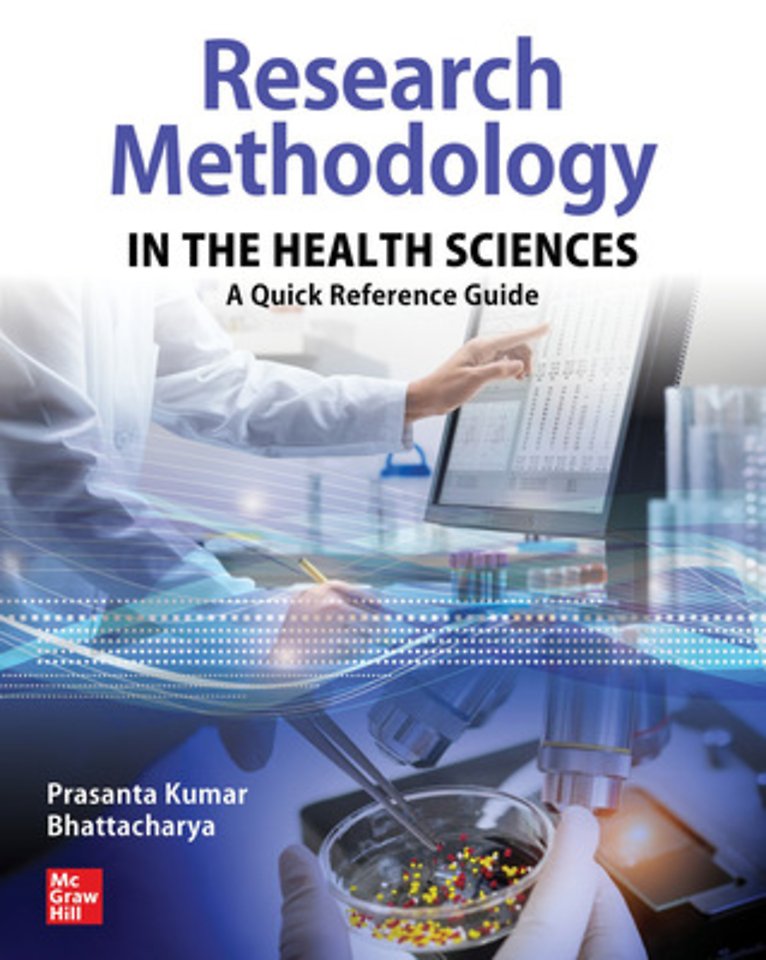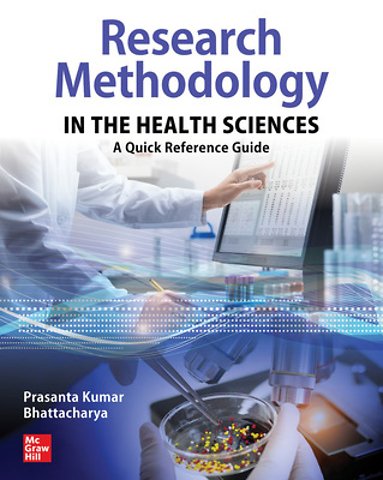Research Methodology in the Health Sciences: A Quick Reference Guide
Samenvatting
Concise, readable, and easy to navigate—a practical and thorough guide to conducting efficient and effective medical research
A Doody's Core Title for 2024 & 2023!
Whether you’re a student, scholar, faculty member, or practicing healthcare professional Research Methodology in the Health Sciences helps you improve your research skills and critically appraise original research and apply it in evidence-based patient care. This peerless guide describes the principles of biostatistics and provides detailed examples to build your comprehension of the utility and applicability of bio-statistical tests, without going into the mathematical details of such tests.
You’ll find accessible coverage of the principles of biomedical ethics in research and publication, review of the medical literature, how to write a dissertation, how to prepare and submit a research manuscript for publication in a journal, how to apply for a research grant to funding agencies, and much more. To enhance the learning process, all examples drawn exclusively from real healthcare scenarios.
Research Methodology in the Health Sciences covers:
Planning a research studyWriting a dissertationTypes of studies in clinical researchObservational and interventional studiesApproaches to qualitative researchEthics in medical researchBiostatistics and descriptive statisticsApproaches to statistical inference
Specificaties
Inhoudsopgave
iew<br> EVIDENCE FROM CLINICAL RESEARCH<br> Evidence from Reviews<br> Different Types of Reviews<br> Clinical Guidelines and Their Utility in Evidence-Based Care<br> Synopsis of Clinical Guidelines<br> HOW TO TRACK THE BEST EVIDENCE<br> Challenges in Evidence-Based Clinical Practice<br> How to Get the Best Answers?<br> Difficulties in Getting the Right Information<br> Literature Search for Evidence-Based Patient Care<br> HIERARCHY OF CLINICAL EVIDENCE<br> Primary Research<br> Secondary Research<br> Clinical Decision Support Systems (CDSS)<br> HOW TO SEARCH THE EVIDENCE, AND ELECTRONIC DATA SEARCH<br> Literature Search Techniques<br> Electronic Databases<br> Compiling the Review Material</p><p>CHAPTER 8. HOW TO WRITE A SCIENTIFIC PAPER<br> CHAPTER OBJECTIVES<br> PREPARATION OF A SCIENTIFIC PAPER<br> Evolution of the Manuscript-Writing Process<br> DIFFERENT TYPES OF ARTICLES AND THEIR STRUCTURES<br> Original Research Articles and the IMRAD Format<br> The Structure of the Original Research Article<br> Additional Formats for Original Research Articles<br> Variations of the IMRAD Structure<br> Structure for Reviews<br> PREPARATION OF THE MANUSCRIPT<br> Background Information<br> Selection of Target Journal<br> Authorship Issues<br> Ethical Concerns<br> HOW TO START WRITING THE MANUSCRIPT<br> FINAL PRESENTATION OF THE ARTICLE<br> Title, Key Words, and Abstract</p><p>PART TWO</p><p>CHAPTER 9. INTRODUCTION TO BIOSTATISTICS AND APPROACH TO DESCRIPTIVE STATISTICS<br> CHAPTER OBJECTIVES<br> WHY STATISTICS IS NECESSARY FOR BIOMEDICAL SCIENCES<br> SOME BASIC ELEMENTS OF BIOSTATISTICS<br> Variable and Data<br> Types of Data<br> Data Measurement Scales<br> PRESENTATION OF THE DATA<br> Different Formats for Data Presentation<br> MEASURES OF CENTRAL TENDENCY AND DISPERSION<br> Measures of Central Tendency<br> Measures of Dispersion</p><p>CHAPTER 10. APPROACH TO STATISTICAL INFERENCE—I<br> CHAPTER OBJECTIVES<br> DEFINITION OF TERMS<br> Population and Sample<br> Statistical Inference<br> Descriptive Measure<br> Parameter and Statistic<br> Element<br> Probability<br> POPULATION AND SAMPLES<br> Population<br> Sample<br> TYPES OF SAMPLING<br> Random Sampling<br> Nonrandom Sampling<br> Type of Sampling Design to Be Selected for Any Research<br> HYPOTHESIS TESTING<br> Types of Hypotheses<br> Hypothesis Testing and the p Value<br> Types of Error<br> Statistical Interpretations and Power<br> The p Value in Practice<br> Statistical Significance versus Clinical Importance<br> Limitations of Hypothesis Testing<br> ESTIMATION<br> Rationale for Estimation in Research in the Health Sciences<br> Types of Estimates<br> CONFIDENCE INTERVALS IN INTERPRETING STUDY RESULTS<br> Confidence Intervals<br> BIAS AND CHANCE<br> Bias<br> Chance<br> Comparing Bias and Chance<br> VALIDITY AND RELIABILITY<br> Validity<br> Reliability</p><p>CHAPTER 11. APPROACH TO STATISTICAL INFERENCE—II<br> CHAPTER OBJECTIVES<br> DEFINITION OF TERMS<br> Measures of Frequency<br> Association and Causation<br> Correlation and Regression<br> INCIDENCE AND PREVALENCE<br> Advantage of Objective over Subjective Reasoning<br> Incidence<br> Prevalence<br> Comparing Prevalence with Incidence<br> ASSOCIATION AND CAUSATION<br> What Is an Association?<br> Types of Variables in an Association<br> MEASURING ASSOCIATION<br> MEASURES OF ASSOCIATION<br> Absolute Measures of Association<br> Relative Measures of Association<br> Practical Application of Measures of Association<br> CORRELATION AND REGRESSION<br> Correlation<br> Regression<br> Regression Analysis<br> CONCEPT OF CAUSAL ASSOCIATION<br> Establishing Association between Variables<br> Establishing the Causality of Association<br> Importance of Establishing Causality of Association<br> Association between Variables</p><p>CHAPTER 12. APPROACH TO STATISTICAL INFERENCE—III<br> CHAPTER OBJECTIVES<br> DIAGNOSIS OF DISEASES<br> What Are Diagnostic Tests?<br> Relation between Diagnostic Test Result and Disease<br> DEFINITIONS OF COMMON TERMS<br> Sensitivity<br> Specificity<br> Positive Predictive Value<br> Negative Predictive Value<br> Likelihood Ratios<br> Prevalence<br> SENSITIVITY AND SPECIFICITY<br> Sensitivity<br> Specificity<br> Clinical Utility and Limitations of Sensitivity and Specificity<br> PREDICTIVE VALUES<br> Positive Predictive Value<br> Negative Predictive Value<br> Predictive Value and Prevalence of the Disease<br> LIKELIHOOD RATIO<br> ESTIMATING PROBABILITY OF DISEASE<br> Pretest and Posttest Probabilities<br> Bayesian Probability<br> TRADE-OFF BETWEEN SENSITIVITY AND SPECIFICITY<br> How to Select the Optimal Cutoff Value<br> STATISTICAL TESTS AND
TECHNIQUES USED IN THE MEDICAL LITERATURE<br> Commonly Used Statistical Tests in Clinical Research<br> Analogy between Diagnostic Tests and Clinical Research<br> Application of Statistical Tests in Clinical Research<br> How to Select a Statistical Test<br> SAMPLE SIZE CALCULATION FOR VARIOUS STUDIES<br> Planning the Sample Size<br> Importance of the Sample Size<br> Statistical Issues in Determining the Sample Size<br> Sample-Size Determination for Different Types of Studies</p><p>Index</p>
Net verschenen
Rubrieken
- aanbestedingsrecht
- aansprakelijkheids- en verzekeringsrecht
- accountancy
- algemeen juridisch
- arbeidsrecht
- bank- en effectenrecht
- bestuursrecht
- bouwrecht
- burgerlijk recht en procesrecht
- europees-internationaal recht
- fiscaal recht
- gezondheidsrecht
- insolventierecht
- intellectuele eigendom en ict-recht
- management
- mens en maatschappij
- milieu- en omgevingsrecht
- notarieel recht
- ondernemingsrecht
- pensioenrecht
- personen- en familierecht
- sociale zekerheidsrecht
- staatsrecht
- strafrecht en criminologie
- vastgoed- en huurrecht
- vreemdelingenrecht

